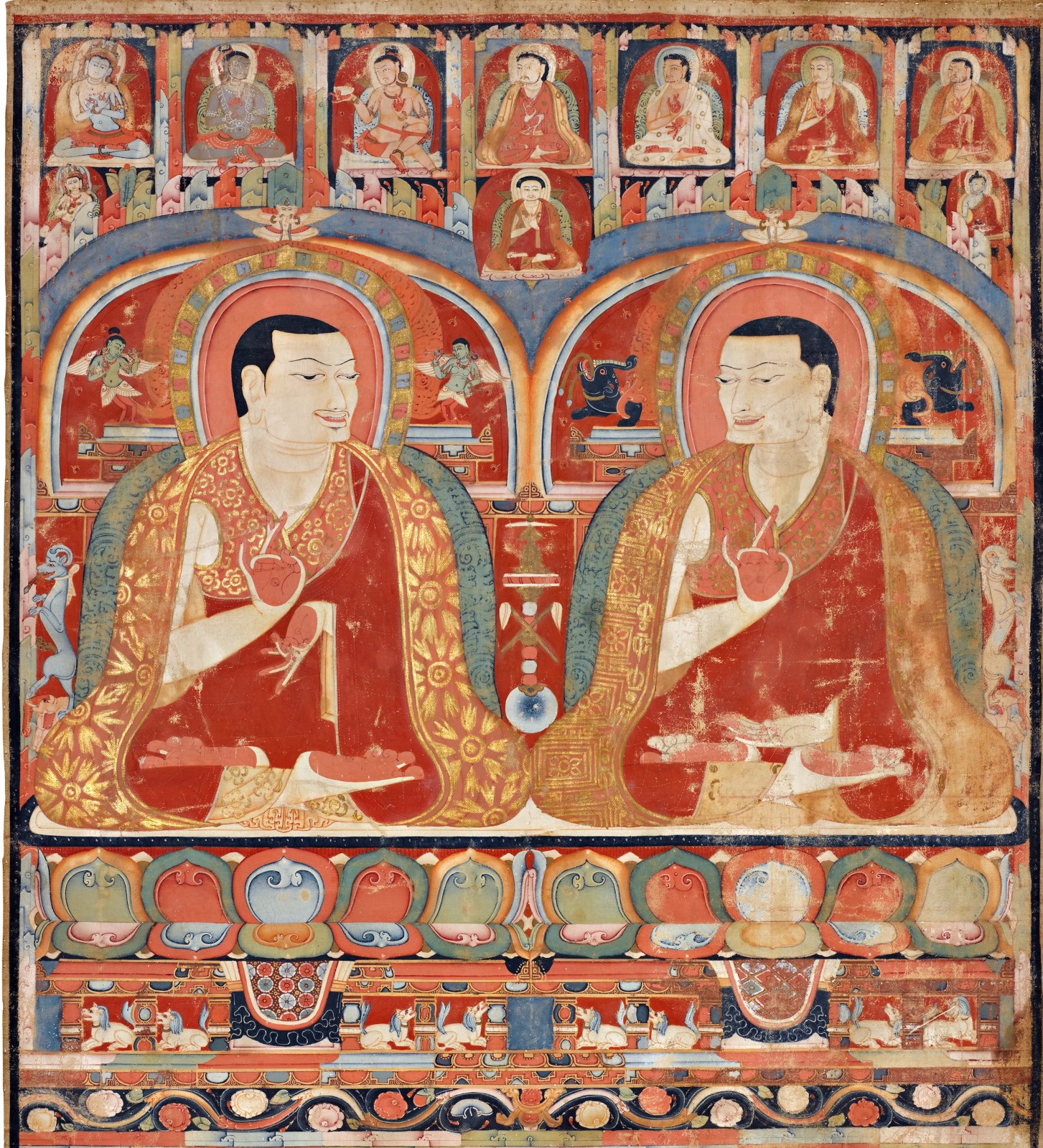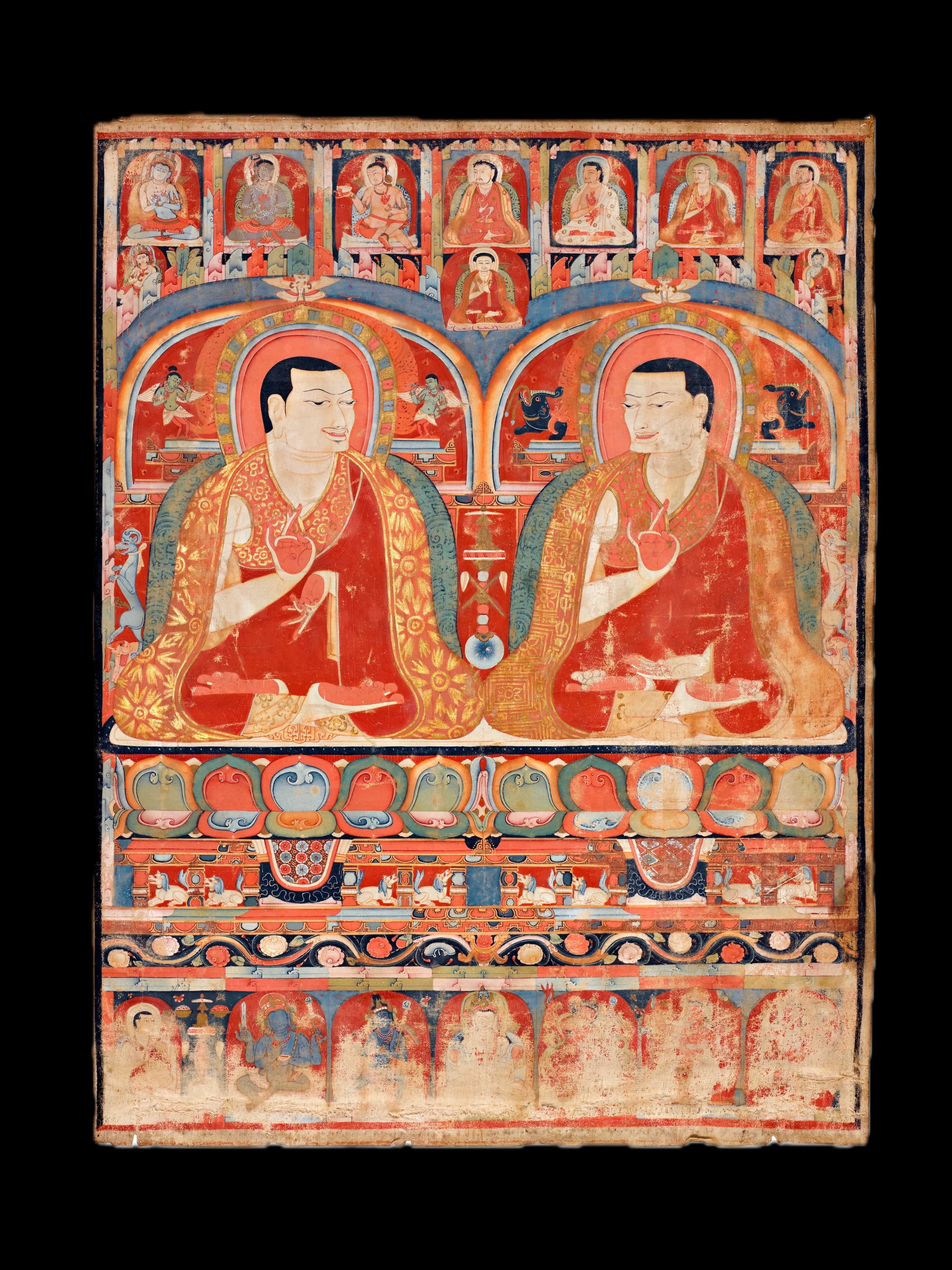
Provenance:
The Richard R. & Magdalena Ernst Collection of Himalayan Art
Sotheby’s, New York, March 22, 2018, no. 916
Published:
Jane Casey, Taklung Painting: A Study in Chronology, Volume I, Chicago, 2023, cat. no. 51, p. 279 and pp. 402-405
This important thangka depicts Kuyelwa (1191-1236) and Sangye Yarjon (1203-1272), the second and third Abbots of Taklung monastery, seated in discourse at the center of the painting.

On the left, Abbot Kuyelwa is shown wearing a red patchwork robe and a floral-patterned cloak. He has closely-cropped black hair, chiseled features, and a thin mustache with a tuft of beard below his slightly-parted lips. His hands are in the dharmachakra mudra (the gesture of turning the wheel of dharma), and he is seated on a lotus throne. The throne, supported by a tiered and stepped snow lion, is draped with a floral textile. Behind him is a green patterned cushion set against a torana (ceremonial archway) featuring a viyala (mythical lion) and an elephant. A pair of male and female kinnara (mythical celestial beings) emerge from swirling oceans on the crossbar above, and a khyung (a type of garuda) perches atop his golden halo.
Abbot Sangye Yarjon is on the right, also wearing a red patchwork robe, but his cloak has geometric and vajra patterns. Like Kuyelwa, he has closely-cropped black hair and chiseled features, but he is clean-shaven. His hands are in the vitarka and dhyana mudras (gestures of discussion and meditation, respectively). He is seated on a lotus throne similar to the one on the left, but his is draped with a geometric textile. A green patterned cushion is behind him against a torana with a viyala and an elephant on the right. An assembly of jewels, ritual objects, and crossed fly whisks is placed between the two Abbots. Makara (mythical sea creatures) emerge from swirling oceans on the crossbar above, and a khyung sits atop his golden halo.
The founder of the Taklung school, Tashipel, is depicted in the dharmachakra mudra and is seated between and above the two Abbots. Above him are depictions of mountains in various colors, with the bodhisattva Vajrapani and Buddha Sakyamuni appearing from behind them on the left and right, respectively. In the upper register, shrines contain images of prominent Buddhist figures, including Vajradhara, Tilopa, Naropa, Marpa, Milarepa, Gampopa, and Phagmodrupa.
In the lower register, a meandering lotus is depicted below the thrones, and a donor monk is shown making offerings. The lower register also contains fragmentary images of several deities: a blue four-armed Mahakala, a blue Heruka, a white Aparajita, and a red Vajravarahi with a blue boar head protruding from her left side. Additionally, two unidentified red deities are visible on the right.
A similar painting in the Cleveland Museum of Art is almost certainly from the same series and depicts Phagmodrupa in discourse with the first Abbot, Taklung Thangpa Chenpo (see Steven M. Kossak and Jane Casey Singer, Sacred Visions: Early Paintings from Central Tibet, New York, 1998, p. 114, cat. no. 26).
The present painting depicting the second and third abbots thus follows the Cleveland painting in the series. No other paintings from the set have come to light thus far, but there is a possibility that others exist, or once existed, depicting succeeding abbots of the monastery, or ones earlier in the series depicting lineage masters. Although the lamas are not identified by inscription, they may be distinguished by the lineage before them. Phagmodrupa, with his distinctive moustache and bearded cheeks, appears at the end of the upper register. Phagmodrupa’s pupil Tashipel, shown between the two main figures, is also identifiable by distinctive features of moustache and three-pointed goatee. Tashipel’s student Kuyelwa, who was abbot 1191-1236 is therefore identifiable as next in line and seated on the left, with the third in line, Sangye Yarjon, abbot 1210-1236, to his right.
Although verisimilitude was not a requirement in Tibetan portraiture, there is evidence that efforts were often made to preserve elements of hierarchs’ physiognomic features and other physical characteristics, even in portraits created long after their deaths. Distinctive shapes of beards and moustaches are more or less reliably consistent throughout the corpus of Taklung portraits and aid identification of individual lamas. Inscriptions on the back of the painting contain vivifying mantras, the ye dharma and patience creeds, and om mani padme hum.
The painting, in common with the Cleveland example, is defined by a vibrant palette and subtle shading giving dimension and animation throughout. The earliest date for the painting would be 1236, when Sangye Yarjon was enthroned as Abbot, but it is not known if there are, or were, any more portraits in the series of succeeding abbots that would thus indicate a later date for the series. A tentative date of circa 1300 is ascribed in comparison with other paintings of the period.
On the verso there are lengthy inscriptions behind the two main figures. Both inscriptions present the Tibetan precept “Patience” verse, followed by the “Ye dharma” verse, also known as the Buddhist creed. It is also referred to as the Dependent Origination dharani.
The “Patience” verse is said to have been spoken by Buddha Vipashyin, and is cited in Buddhist vinaya literature. It may be translated as follows:
The holy ascetic practice of patience is the best path to Buddhahood, thus the Buddha has said. For a monk to harm others is not virtuous practice.
The Buddhist creed may be translated as follows:
Of those phenomena which arise from causes,
Those causes have been taught by the Tathagata [Buddha]
And their cessation too, thus proclaims the Great Ascetic.
